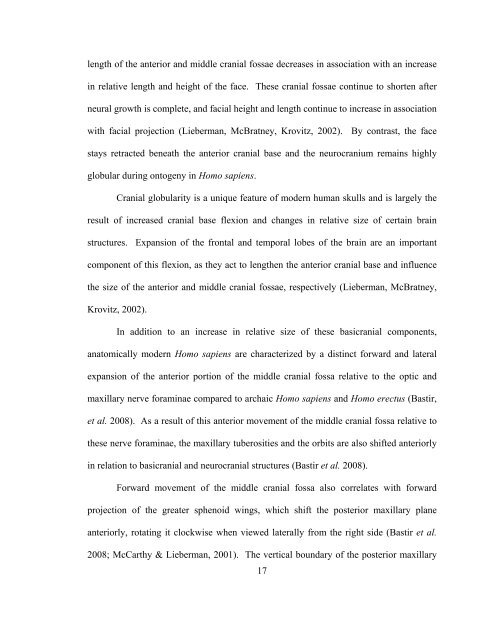modern variation and evolutionary change in the hominin eye orbit
modern variation and evolutionary change in the hominin eye orbit
modern variation and evolutionary change in the hominin eye orbit
Create successful ePaper yourself
Turn your PDF publications into a flip-book with our unique Google optimized e-Paper software.
length of <strong>the</strong> anterior <strong>and</strong> middle cranial fossae decreases <strong>in</strong> association with an <strong>in</strong>crease<strong>in</strong> relative length <strong>and</strong> height of <strong>the</strong> face. These cranial fossae cont<strong>in</strong>ue to shorten afterneural growth is complete, <strong>and</strong> facial height <strong>and</strong> length cont<strong>in</strong>ue to <strong>in</strong>crease <strong>in</strong> associationwith facial projection (Lieberman, McBratney, Krovitz, 2002). By contrast, <strong>the</strong> facestays retracted beneath <strong>the</strong> anterior cranial base <strong>and</strong> <strong>the</strong> neurocranium rema<strong>in</strong>s highlyglobular dur<strong>in</strong>g ontogeny <strong>in</strong> Homo sapiens.Cranial globularity is a unique feature of <strong>modern</strong> human skulls <strong>and</strong> is largely <strong>the</strong>result of <strong>in</strong>creased cranial base flexion <strong>and</strong> <strong>change</strong>s <strong>in</strong> relative size of certa<strong>in</strong> bra<strong>in</strong>structures. Expansion of <strong>the</strong> frontal <strong>and</strong> temporal lobes of <strong>the</strong> bra<strong>in</strong> are an importantcomponent of this flexion, as <strong>the</strong>y act to leng<strong>the</strong>n <strong>the</strong> anterior cranial base <strong>and</strong> <strong>in</strong>fluence<strong>the</strong> size of <strong>the</strong> anterior <strong>and</strong> middle cranial fossae, respectively (Lieberman, McBratney,Krovitz, 2002).In addition to an <strong>in</strong>crease <strong>in</strong> relative size of <strong>the</strong>se basicranial components,anatomically <strong>modern</strong> Homo sapiens are characterized by a dist<strong>in</strong>ct forward <strong>and</strong> lateralexpansion of <strong>the</strong> anterior portion of <strong>the</strong> middle cranial fossa relative to <strong>the</strong> optic <strong>and</strong>maxillary nerve foram<strong>in</strong>ae compared to archaic Homo sapiens <strong>and</strong> Homo erectus (Bastir,et al. 2008). As a result of this anterior movement of <strong>the</strong> middle cranial fossa relative to<strong>the</strong>se nerve foram<strong>in</strong>ae, <strong>the</strong> maxillary tuberosities <strong>and</strong> <strong>the</strong> <strong>orbit</strong>s are also shifted anteriorly<strong>in</strong> relation to basicranial <strong>and</strong> neurocranial structures (Bastir et al. 2008).Forward movement of <strong>the</strong> middle cranial fossa also correlates with forwardprojection of <strong>the</strong> greater sphenoid w<strong>in</strong>gs, which shift <strong>the</strong> posterior maxillary planeanteriorly, rotat<strong>in</strong>g it clockwise when viewed laterally from <strong>the</strong> right side (Bastir et al.2008; McCarthy & Lieberman, 2001). The vertical boundary of <strong>the</strong> posterior maxillary17
















